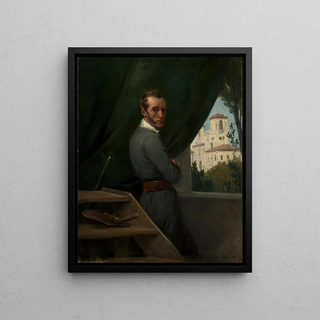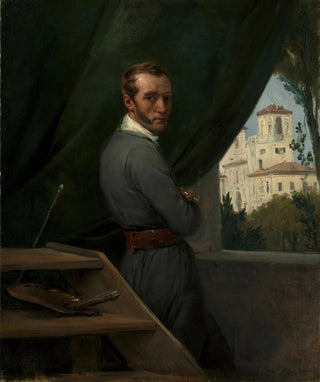Art print | Self-portrait in Rome - Horace Vernet


View from behind

Frame (optional)
Autoportrait at Rome - Horace Vernet – Captivating Introduction
The Autoportrait at Rome by Horace Vernet is an iconic work that transcends mere representation. Painted in 1835, this painting reveals not only the undeniable talent of the artist but also a pivotal period in art history. Vernet, renowned for his battle scenes and landscapes, here engages in an introspective exercise, capturing both his essence and the vibrant atmosphere of the eternal city. By contemplating this piece, the viewer is invited to delve into the mind of a man who, through his brush, dialogues with his era while aligning with the tradition of great masters.
Style and uniqueness of the work
The Autoportrait at Rome stands out for its bold approach and masterful treatment of colors. Vernet chooses to depict himself in a moment of reflection, dressed in a way that evokes both simplicity and depth. Light plays a leading role, illuminating his face while creating subtle shadows that add an almost sculptural dimension to his portrait. The composition, although classical in its essence, reveals a modernity that foreshadows upcoming artistic movements. The details, meticulously rendered, testify to Vernet's technical mastery, while the background, reminiscent of Roman ruins, underscores the unbreakable connection between the artist and the surrounding culture. This painting is a celebration of individuality, an invitation to contemplate not only the image of the artist but also the soul of a creator in search of his identity.
The artist and his influence
Horace Vernet, born in 1789, is often regarded as one of the most influential painters of the 19th century. Son of the famous painter Carle Vernet, he grew up in an environment where art and creativity were omnipresent. His artistic journey led him to explore various genres, but it is his commitment to realism and his ability to capture the spirit of his time that set him apart. Vernet is also recognized for his role in promoting the Romantic movement in France, using his painting to express intense emotions and historical narratives. His influence extends

Matte finish

View from behind

Frame (optional)
Autoportrait at Rome - Horace Vernet – Captivating Introduction
The Autoportrait at Rome by Horace Vernet is an iconic work that transcends mere representation. Painted in 1835, this painting reveals not only the undeniable talent of the artist but also a pivotal period in art history. Vernet, renowned for his battle scenes and landscapes, here engages in an introspective exercise, capturing both his essence and the vibrant atmosphere of the eternal city. By contemplating this piece, the viewer is invited to delve into the mind of a man who, through his brush, dialogues with his era while aligning with the tradition of great masters.
Style and uniqueness of the work
The Autoportrait at Rome stands out for its bold approach and masterful treatment of colors. Vernet chooses to depict himself in a moment of reflection, dressed in a way that evokes both simplicity and depth. Light plays a leading role, illuminating his face while creating subtle shadows that add an almost sculptural dimension to his portrait. The composition, although classical in its essence, reveals a modernity that foreshadows upcoming artistic movements. The details, meticulously rendered, testify to Vernet's technical mastery, while the background, reminiscent of Roman ruins, underscores the unbreakable connection between the artist and the surrounding culture. This painting is a celebration of individuality, an invitation to contemplate not only the image of the artist but also the soul of a creator in search of his identity.
The artist and his influence
Horace Vernet, born in 1789, is often regarded as one of the most influential painters of the 19th century. Son of the famous painter Carle Vernet, he grew up in an environment where art and creativity were omnipresent. His artistic journey led him to explore various genres, but it is his commitment to realism and his ability to capture the spirit of his time that set him apart. Vernet is also recognized for his role in promoting the Romantic movement in France, using his painting to express intense emotions and historical narratives. His influence extends






